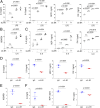IL-6 trans-signaling induces plasminogen activator inhibitor-1 from vascular endothelial cells in cytokine release syndrome
- PMID: 32826331
- PMCID: PMC7486751
- DOI: 10.1073/pnas.2010229117
IL-6 trans-signaling induces plasminogen activator inhibitor-1 from vascular endothelial cells in cytokine release syndrome
Abstract
Cytokine release syndrome (CRS) is a life-threatening complication induced by systemic inflammatory responses to infections, including bacteria and chimeric antigen receptor T cell therapy. There are currently no immunotherapies with proven clinical efficacy and understanding of the molecular mechanisms of CRS pathogenesis is limited. Here, we found that patients diagnosed with CRS from sepsis, acute respiratory distress syndrome (ARDS), or burns showed common manifestations: strikingly elevated levels of the four proinflammatory cytokines interleukin (IL)-6, IL-8, monocyte chemotactic protein-1 (MCP-1), and IL-10 and the coagulation cascade activator plasminogen activator inhibitor-1 (PAI-1). Our in vitro data indicate that endothelial IL-6 trans-signaling formed an inflammation circuit for robust IL-6, IL-8, and MCP-1 production and promoted PAI-1 production; additionally, an IL-6 signaling blockade by the human monoclonal antibody tocilizumab blunted endothelial cell activation. Plasma from severe COVID-19 patients similarly exhibited increased IL-6, IL-10, and MCP-1 levels, but these levels were not as high as those in patients with CRS from other causes. In contrast, the PAI-1 levels in COVID-19 patients were as highly elevated as those in patients with bacterial sepsis or ARDS. Tocilizumab treatment decreased the PAI-1 levels and alleviated critical illness in severe COVID-19 patients. Our findings suggest that distinct levels of cytokine production are associated with CRS induced by bacterial infection and COVID-19, but both CRS types are accompanied by endotheliopathy through IL-6 trans-signaling. Thus, the present study highlights the crucial role of IL-6 signaling in endothelial dysfunction during bacterial infection and COVID-19.
Keywords: COVID-19; IL-6; cytokine release syndrome; endothelial cell; tocilizumab.
Copyright © 2020 the Author(s). Published by PNAS.
Conflict of interest statement
Competing interest statement: T.K. holds a patent for tocilizumab and receives royalties from Actemra.
Figures




Comment in
-
COVID-19 induces lower levels of IL-8, IL-10, and MCP-1 than other acute CRS-inducing diseases.Proc Natl Acad Sci U S A. 2021 May 25;118(21):e2102960118. doi: 10.1073/pnas.2102960118. Proc Natl Acad Sci U S A. 2021. PMID: 33972411 Free PMC article. No abstract available.
References
-
- Moore J. B., June C. H., Cytokine release syndrome in severe COVID-19. Science 368, 473–474 (2020). - PubMed
-
- van der Poll T., van de Veerdonk F. L., Scicluna B. P., Netea M. G., The immunopathology of sepsis and potential therapeutic targets. Nat. Rev. Immunol. 17, 407–420 (2017). - PubMed
-
- Norelli M. et al. ., Monocyte-derived IL-1 and IL-6 are differentially required for cytokine-release syndrome and neurotoxicity due to CAR T cells. Nat. Med. 24, 739–748 (2018). - PubMed
Publication types
MeSH terms
Substances
LinkOut - more resources
Full Text Sources
Research Materials
Miscellaneous

